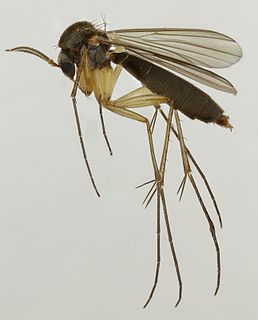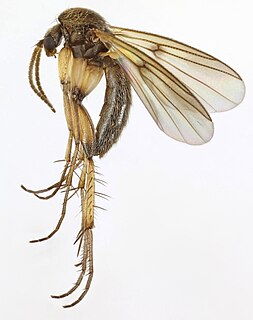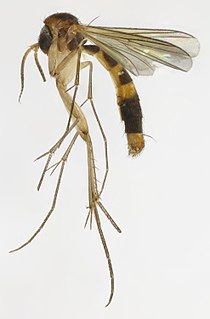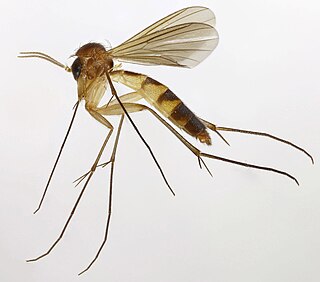
The Nematocera are a suborder of elongated flies with thin, segmented antennae and mostly aquatic larvae. Major families in the suborder include the mosquitoes, crane flies, gnats, black flies, and a group of families described as midges.

The Mycetophilidae are a family of small flies, forming the bulk of those species known as fungus gnats. About 3000 described species are placed in 150 genera, but the true number of species is undoubtedly much higher. They are generally found in the damp habitats favoured by their host fungi and sometimes form dense swarms.

Sciaroidea is a superfamily in the infraorder Bibionomorpha. There are about 16 families and more than 15,000 described species in Sciaroidea. Most of its constituent families are various gnats.

The Diadocidiidae are a family of flies (Diptera), containing one extant genus with over 20 species and one extinct genus. Diadocidiidae are found worldwide, except in Africa and Antarctica. They are usually considered close to the Keroplatidae, Bolitophilidae, and Ditomyiidae, and used to be included in the Mycetophilidae. They are woodland flies, found in shaded places in forests or near streams. The larvae spin silken tubes under bark or in dead logs, and feed on hymenium of Polyporaceae fungi. The average body length for adults is around 2.5–5.6 mm.

Bolitophila is the sole living genus in the Bolitophilidae, a family of Diptera in the superfamily Sciaroidea, with around 40 Palaearctic and about 20 Nearctic species, and three species from the Oriental region (Taiwan). They are small (6–9 mm.)

The Ditomyiidae are a small family of flies (Diptera).They are found worldwide, most species are found in the Australasian and Neotropical realms. There are only two genera in Europe Ditomyia Winnertz, 1846 and Symmerus Walker, 1848 Ditomyia is found in Central Europe Symmerus in Northern Europe Symmerus is endemic to the Palaearctic.

Diadocidia ferruginosa is a Palearctic species of fungus gnat in the family Mycetophilidae. They live as larvae in long dry silken tubes under bark or in rotten wood and probably feed on fungal mycelia or spores. Also associated with Peniophora.
Leptomorphus is a genus of fungus gnats in the family Mycetophilidae. There are about 8 described species in Leptomorphus.

Lygistorrhinidae is a family of long-beaked fungus gnats in the order Diptera. There are about 7 genera and at least 30 described species in Lygistorrhinidae.

Zygomyia is a genus of fungus gnats in the family Mycetophilidae. There are at least 80 described species in Zygomyia.

Mycetophilinae is a subfamily of fungus gnats in the family Mycetophilidae. There are more than 30 genera and 2,000 described species in Mycetophilinae.

Symmerus is a genus of fungus gnats and gall midges in the family Ditomyiidae. There are about five described species in Symmerus.
Eudicrana is a genus of fungus gnats in the family Mycetophilidae. There are about 13 described species in Eudicrana.
Mycetophila elegans is a species of 'fungus gnats' in the family Mycetophilidae.
Probolaeus is a genus of long-beaked fungus gnats in the family Lygistorrhinidae.

Ditomyia is a genus of fungus gnats in the family Ditomyiidae.
Rhipidita is a genus of fungus gnats in the family Ditomyiidae.
Australosymmerus is a genus of fungus gnats in the family Ditomyiidae.

Exechiopsis is a genus of fungus gnats in the family Mycetophilidae.










